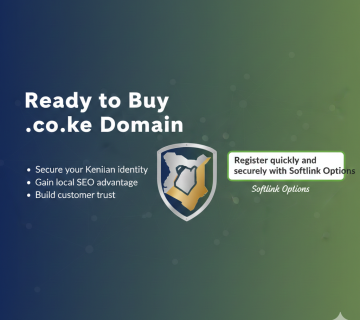WHAT IS A DOMAIN NAME?
A domain name (e.g a .co.ke domain name) is a website’s equivalent of a physical address. In the same way that a GPS needs a street address or a location name to provide directions. A web browser like Chrome or Internet Explorer needs a domain name to direct you to a website.
A domain name has two main elements. For example, the domain name softlinkoptions.co.ke consists of the website’s name (softlinkoptions) and the domain name extension (.co.ke). When a company purchases a domain name, they are able to specify which server the domain name points.
Domain name registrations are overseen by an organization called ICANN (Internet Corporation for Assigned Names and Numbers). And in Kenya they are over they are over seen by a local registry KENIC (KE). ICANN or KENIC specify which domain name extensions are available. They keeps a centralized database of where the domain names point to.
Elements Of A Website
Every website that you visit effectively consists of two main elements: a domain name and a web server.
A web server is a physical machine that hosts the files and the databases that your website is made from. Also sends them out to people across the internet when they visit your site from their machine.
The domain name is what people type in to access your site. And it points the web browser to the server that stores those resources. Without a domain name, people would need to remember the specific IP address of your server. And that’s just not going to happen, there are usually long. Also difficult to remember so the domain name provides an easy enough memorable word.
HOW .CO.KE DOMAIN NAMES WORK?
A domain name works by acting as a link or alternative name to the server that hosts your website.
Without a domain name, anyone who wanted to visit your website would have to enter the full IP address which is usually 12 to 15 digit number. But the problem is that an IP address is difficult for people to memorize or to include on advertising materials.
For example, www.softlinkoptions.co.ke is our domain name. Let’s say it points to the IP address 162.241.159.80.70. The IP address points to a server, but it doesn’t lead to the website if visitors try to use it. That’s because for an IP address to lead a website, the remote server needs to be using port 80 with a default page (i.e. index.html) stored in its public accessible directory.
As you can see, messing around with server defaults and IP addresses can be both confusing and time-consuming. That’s why the vast majority of website owners opt to utilize a service like Softlink Options which offers domain name registration services with annual web hosting packages.
Domain names can also use redirects, which essentially allow you to specify that if people visit your domain, they’re automatically forwarded to another. This can be useful for campaigns and microsites or for forwarding people to dedicated landing pages on your main site.
We have very many types of domain names, while .com domains make up for 46.5% of all global registered domain names, it still leaves plenty of room for other domain name types like .org and .net. Overall, the most common types of domain names include:
Types of Domain Names
TLD: Top Level Domain Names
A top level domain is exactly what it sounds like: a type of domain name which is at the top level of the internet’s domain name system. There are over a thousand TLDs available but the most common include .com, .org, .net, and .edu.
The official list of TLDs is maintained by an organization called the Internet Assigned Numbers Authority (IANA) and can be viewed here. IANA notes that the list of TLDs also includes ccTLDs and gTLDs, which we’ll talk about next.
ccTLD: Country Code Top Level Domain Names
ccTLDs use just two letters and are based upon international country codes, such as .ke for Kenya and .jp for Japan. They’re often used by companies that are building dedicated sites for specific regions and can be a good way of signaling to users that they’ve arrived at the right place.
gTLD: Generic Top Level Domain Names
A gTLD is essentially a top-level domain that doesn’t rely on a country code. Many gTLDs are intended for a specific use-case, such as .edu which is aimed at educational institutions. That said, you don’t have to meet any specific criteria to register a gTLD, which is why a .com domain might not necessarily be used for commercial purposes.
Other examples of gTLDs include .mil (military), .gov (government), .org (for non-profits and organizations), and .net, which was originally designed for internet service providers (ISPs) but is now used more widely.
Other Domain Name Types
While the above-mentioned domain name categories are the most frequent, there are other variations that you can run into.
Second-Level Domain Names
You’ve probably seen these domain names before. We’re talking about a domain that sits directly below a top-level domain name. We’re not going to get too technical here because it’s easier to show with examples, particularly when it comes to country codes.
For example, Kenya companies occasionally use .co.ke instead of .com, and it’s a perfect example of a second-level domain. Another second-level domain is .go.ke, which is often used by governmental institutions, and .ac.ke, which is used by academic institutions and universities.
Sub-domain Names
Subdomains are useful because they don’t require webmasters to purchase an additional domain name to create divisions within their site. Instead, they’re able to create a subdomain that effectively points to a specific directory on the server. This can be super useful for campaign sites, micro sites and other types of web content that should be kept separate from the main site.
For example, Facebook uses developers.facebook.com to provide specific information for web and app developers who want to use the Facebook API. Another great example is support.google.com


